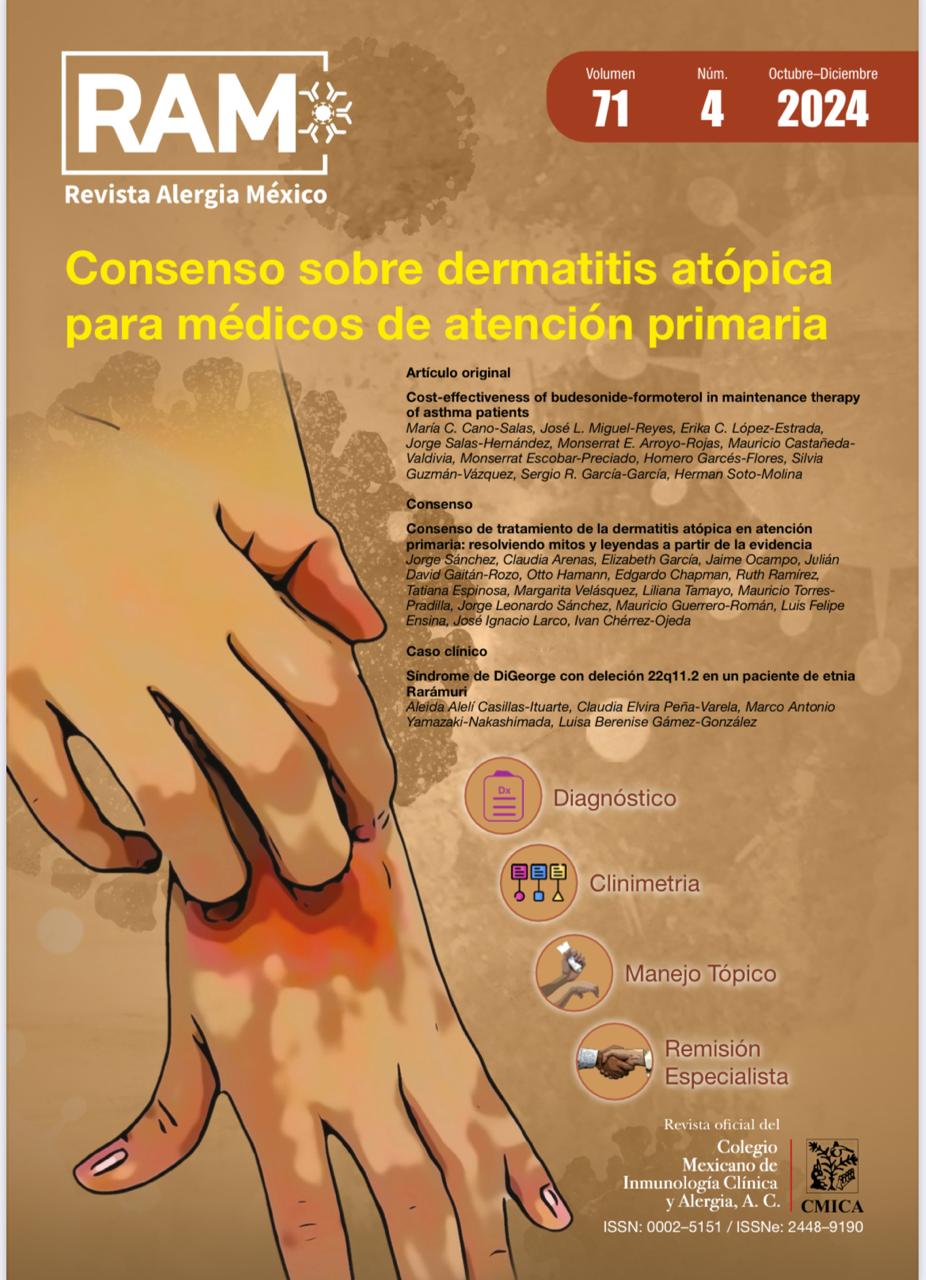Abstract
Objectives: To evaluate the prevalence of methylisothiazolinone (MI) sensitivity and associated factors in individuals with suspected allergic contact dermatitis.
Methods: Cross-sectional study based on patch tests, including methylisothiazolinone 0.2%, in 286 participants with suspected allergic contact dermatitis, in Brasília/DF, Brazil, between March/2020 and March/2022.
Results: 13.6% of participants were diagnosed with allergic contact dermatitis and sensitive to MI. The mean age was 43.7 years, and the majority were women (71,8%). The average duration of the disease was 60 months. The most common location was hands (76.9%) and upper limbs (33.3%). In 97.4%, allergy to methylisothiazolinone was considered of current relevance. In the multivariate model, being domestic/household increased the chance of presenting sensitivity to MI by 4.2 (95% CI= 1.36 - 13.5). Presenting lesions in several places of the body was also significantly associated (OR=2.84; CI 95%=1.17 - 6.86) to be sensitive to the test substance.
Conclusion: The findings confirm the epidemic of allergy to methylisothiazolinone. They reinforce the need for the inclusion of this isolated substance in the Brazilian baseline series. We emphasize the need for regulations on the use of methylisothiazolinone in industrial products and household detergents, as is done for cosmetics. Studies in other centers are needed to confirm these results.
Keywords: Prevalence; Methylisothiazolinone; Allergic contact dermatitis; Allergy; Epidemiology; Detergents; Industrial products.
References
1. Herman A, Aerts O, de Montjoye L, Tromme I, et al. Isothiazolinone derivatives and allergic contact dermatitis: a review and update. J Eur Acad Derm. atology Venereol 2019; 33 (2): 267-76. http://doi.wiley.com/10.1111/jdv.15267
2. Özkaya E, Kılıç-Sayar S, Babuna-Kobaner G, Pehlivan G. Methylchloroisothiazolinone/methylisothiazolinone and methylisothiazolinone contact allergy: A 24-year, single-center, retrospective cohort study from Turkey. Contact Dermatitis 2021; 24; 84 (1): 24-33. https://onlinelibrary.wiley.com/doi/10.1111/cod.13656
3. Reeder MJ, Warshaw E, Aravamuthan S, et al. Trends in the Prevalence of Methylchloroisothiazolinone/ Methylisothiazolinone Contact Allergy in North America and Europe. JAMA 2023; 53715 (3). https://doi.org/10.1001/jamadermatol.2022.5991
4. Torres AB. Resolução de Diretoria Colegiada - RDC No 528, de 4 de agosto de 2021. Brasília, Brasil; 2021 p. 97.
5. Pónyai G, Németh I, Nagy G, Fábos B, et al. Methylchloroisothiazolinone/methylisothiazolinone and methylisothiazolinone hypersensitivity in 1122 patients: A national multicenter study organized by the Hungarian Contact Dermatitis Group. Contact Derm 2019; 81 (6): 467-9. https://onlinelibrary.wiley.com/doi/10.1111/cod.13370
6. Puangpet P, Chawarung A, McFadden JP. Methylchloroisothiazolinone/Methylisothiazolinone and Methylisothiazolinone Allergy. Dermatitis 2020; 31 (1): 99-102.
7. Latheef F, Wilkinson SM. Contact Dermatitis to Isothiazolinone Preservatives. Curr Dermatol Rep 2023; 12 (2): 38-44. https://doi.org/10.1007/s13671-023-00387-8
8. Villarinho ALCF, Melo M das GM, Teixeira LR. Allergic contact dermatitis and photosensitivity to methylisothiazolinone and methylchloroisothiazolinone/methylisothiazolinone: Portrait of an epidemic in Brazil. Contact Derm 2020; 82 (4): 258-9. https://onlinelibrary.wiley.com/doi/10.1111/cod.13456
9. Belluco PES, Giavina-Bianchi P. Dermatite de contato à metilisotiazolinona – estamos atentos a essa epidemia? Brazilian J Allergy Immunol 2019; 3 (2): 139-42.
10. Lachapelle J-M, Maibach HI. Patch Testing Methodology. In: Lachapelle J, editor. Patch Testing and Prick Testing. Cham: Springer International Publishing; 2020. p. 39–84.
11. Isaksson M, Ale I, Andersen KE, Cannavó A, et al. Revised Baseline Series of the International Contact Research Group. Derm 2020; 31 (1): e5-7. https://doi.org/10.1097/DER.0000000000000532
12. Tam I, Yu J, Ko LN, Schalock PC. Patch Testing With an Extended Metal Allergen Series at the Massachusetts General Hospital (2006–2017). Dermatitis 2020; 31 (6): 359-66. https://doi.org/10.1097/DER.0000000000000609
13. DeKoven JG, Warshaw EM, Reeder MJ, Atwater AR, et al. North American Contact Dermatitis Group Patch Test Results: 2019–2020. Dermatitis 2023; 34 (2): 90-104. https://doi.org/10.1089/derm.2022.29017.jdk
14. Veverka KK, Hall MR, Yiannias JA, Drage LA, et al. Trends in Patch Testing With the Mayo Clinic Standard Series, 2011-2015. Dermatitis 2018; 29 (6): 310-5. https://doi.org/10.1097/DER.0000000000000411
15. Ljubojević-Hadžavdić S, Uter W, Ilijanić-Samošćanec M, Johansen JD. Methylisothiazolinone contact allergy in Croatia: Epidemiology and course of disease following patch testing. Contact Derm 2018; 79 (3): 162-7. https://onlinelibrary.wiley.com/doi/10.1111/cod.13028
16. Zirwas MJ, Hamann D, Warshaw EM, Maibach HI, et al. Epidemic of Isothiazolinone Allergy in North America: Prevalence Data From the North American Contact Dermatitis Group, 2013–2014. Derm 2017; 28 (3): 204-9. https://doi.org/10.1097/DER.0000000000000288
17. Sukakul T, Limphoka P, Boonchai W. Methylchloroisothiazolinone and/or Methylisothiazolinone Contact Allergies in Thailand. Derma 2021; 32 (6): 375-80. https://doi.org/10.1097/DER.0000000000000537
18. Silva EA, Bosco MRM, Lozano RR, Latini ACP, et al. High rate of sensitization to Kathon CG, detected by patch tests in patients with suspected allergic contact dermatitis. An Bras Dermatol 2020; 95 (2): 194-9. https://doi.org/10.1016/j.abd.2019.09.026
19. Magdaleno‐Tapial J, Valenzuela‐Oñate C, Ortiz‐Salvador JM, García‐Legaz‐Martínez M, et al. Contact allergy to isothiazolinones epidemic: Current situation. Contact Derm 2020; 82 (2): 83-6. https://onlinelibrary.wiley.com/doi/10.1111/cod.13396
20. Schwensen JF, Lundov MD, Bossi R, Banerjee P, et al. Methylisothiazolinone and benzisothiazolinone are widely used in paint: a multicentre study of paints from five European countries. Contact Derm 2015; 72 (3): 127-38. https://onlinelibrary.wiley.com/doi/10.1111/cod.12322
21. Thomsen AV, Schwensen JF, Bossi R, Banerjee P, et al. Isothiazolinones are still widely used in paints purchased in five European countries: a follow-up study. Contact Derm 2018; 78 (4): 246-53. https://onlinelibrary.wiley.com/doi/10.1111/cod.12937
22. Johansen JD, Bonefeld CM, Schwensen JFB, Thyssen JP, et al. Novel insights into contact dermatitis. J Allergy Clin Immunol 2022; 149 (4): 1162-71. https://doi.org/10.1016/j.jaci.2022.02.002

This work is licensed under a Creative Commons Attribution-NonCommercial 4.0 International License.
Copyright (c) 2024 Revista Alergia México





